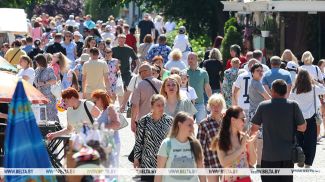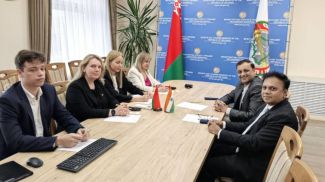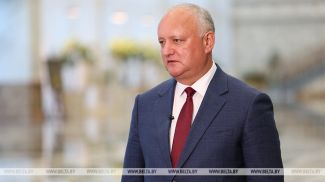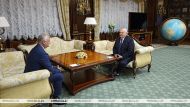The UN General Assembly declared 12 April as the International Day of Human Space Flight. On this day Yuri Gagarin made the first space flight.
Yuri Gagarin is the world's first pilot cosmonaut, who flew in the spaceship Vostok on 12 April 1961
Cosmonaut Valentina Tereshkova, 1963
Anna Gagarina (left), Anastasia Kupriyanova and Olga Kovalenok. Meeting of three mothers with pioneers of Zhodino, Minsk Oblast, 2 August 1978
Since the first days of space exploration, Belarus has not been left behind. The first space developments in the country date back to the early 1960s. Scientific institutes and industrial enterprises developed advanced optical instruments, ground-based rocket launch control systems, and space image processing programs. During the Soviet period, two natives of Belarus - Vladimir Kovalyonok and Pyotr Klimuk - went into space.
Vladimir Kovalyonok, Soviet cosmonaut, 1978
Pilot-Cosmonaut Pyotr Klimuk among students of the Belarusian State University, 1974
Belarusian cosmonaut, twice Hero of the Soviet Union Pyotr Klimuk spent a week in the Soyuz-13 spacecraft in December 1973 and then went into space again in May 1975 to spend 63 days in orbit.
Soyuz-13 spaceship crew - spaceship commander Pyotr Klimuk (right) and flight engineer Valentin Lebedev - in Soyuz simulator at Yuri Gagarin Cosmonaut Training Center, 1973
Twice Hero of the Soviet Union Pyotr Klimuk with the youth of Brest, 1975
Marfa Klimuk, mother of pilot-cosmonaut Pyotr Klimuk, 1973
Pyotr Klimuk presents a Komsomol card to Yury Yeshchik, a ninth-grader at Skidel secondary school, 1978
A bronze bust of Pyotr Klimuk was installed in Brest, and a cosmonaut museum was opened in the cosmonaut's homeland in 1978
First Belarusian cosmonaut Pyotr Klimuk visits his native village of Tomashovka, Brest Oblast, 2018
Pyotr Klimuk is a scientist in the field of technical sciences, a pilot-cosmonaut of the USSR, Colonel General of Aviation, a corresponding member of the International Academy of Astronautics, an academician of the Russian Academy of Astronautics, Doctor of Technical Sciences
Another Belarusian who conquered space is Vladimir Kovalyonok. He was not yet twenty-two years old when he arrived in the aviation unit. Vladimir Kovalyonok has been in orbit three times and for a total of 216 days: in 1977, 1978, and 1981.
USSR pilot-cosmonaut, twice Hero of the Soviet Union Vladimir Kovalyonok among the delegates of the 22nd Minsk Oblast Komsomol Conference, 1982
Olga Ivanovna, mother of cosmonaut Vladimir Kovalyonok, and her loved ones reading about her son's flight into space in the newspaper, 1977
Cosmonauts Vladimir Kovalyonok and Aleksandr Ivanchenkov before space flight in 1978
The Cosmos pavilion opened on 4 June at the DOSAAF airclub in Minsk (Borovaya settlement). Pictured is Vladimir Kovalyonok, 2016
A total of three Belarusians in the history of astronautics have flown into space. Oleg Novitsky was the third to fly into space in 2012 as commander of the Soyuz TMA-06M spacecraft.
Oleg Novitsky – commander of Soyuz MS-03 that was launched from Baikonur Cosmodrome
The Cosmos pavilion opened at the Minsk Aeroclub DOSAAF (in the town of Borovaya) on 4 June. Pictured: Oleg Novitsky, 2016
Belarusian school students during the first open lesson “Belarus and Cosmos” in the country. Pictured: Piotr Klimuk, Vladimir Kovalenok, and Oleg Novitsky
The 6th Belarusian Space Congress in Minsk. Pictured: cosmonauts Oleg Novitsky, Piotr Klimuk, and Vladimir Kovalenok, 2014
The Belarusian satellite for the remote sensing of Earth was launched from Kazakhstan's Baikonur Cosmodrome at 9:41 Minsk time on 22 July
The launch of its own satellite for the remote sensing of Earth on 22 July 2012 was a strategically important move for Belarus. It was launched in a cluster of five spacecraft, together with Russian Kanopus-B and MKA-FKI (Zond-PP), German TET-1, and Canadian ADS-1B.
The Belarusian satellite was launched from Baikonur Cosmodrome in 2012
The decision to develop the satellite (the remote-sensing satellite was meant to facilitate the work of the Emergencies Ministry, agriculture and the forestry industry) and the Belarusian space system of remote sensing of the Earth was made by the president in 2003. The launch of its own satellite made Belarus a spacefaring nation. At the 68th session of the UN General Assembly, Belarus became a member of the UN Committee on the Peaceful Uses of Outer Space.
The Belintersat-1 satellite was launched from a cosmodrome in China
On 15 January 2016, Belarusian launched the telecommunications satellite Belintersat-1. It lifted off on a Chinese Long March CZ-3B/E rocket from Xichang Satellite Launch Center at 19:57 Minsk time.
The Belarusian telecommunications satellite Belintersat-1 provides TV and radio broadcasting and broadband internet access
The Belarusian telecommunications satellite Belintersat-1 is set to operate for 15 years
Aleksandr Lukashenko with cosmonauts Piotr Klimuk and Vladimir Kovalenok at the opening of the 31st International Congress of the Association of Space Flight Participants in 2018
By now, Belarus has created the necessary infrastructure to receive, transfer, and process information from space. The Belarusian remote-sensing satellite, the telecommunications satellite Belintersat-1, and the educational nanosatellite BSU Sat-1 of Belarusian State University operate in the Earth orbit.
The BSU was the first Belarusian university to develop its own nanosatellite. It weights around two kilograms and consists of two basic modules. The satellite has all the elements of big satellites: it is equipped with an orientation system, a digital camera, and registration sensors
The nanosatellite was developed by the BSU
Belarus is currently getting ready to launch another satellite. The new Russian-Belarusian satellite is in the works.
The Belarus-Russia reception complex
Mission control center of the Belarusian remote-sensing satellite, 2021
The Belarus Intellectual exhibition in the National Academy of Science of Belarus. Pictured: the Russian-Belarusian spacecraft, 2020
Follow us on:














